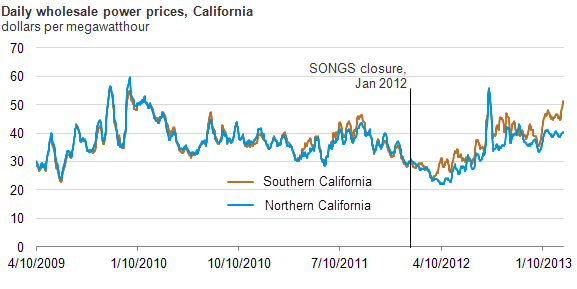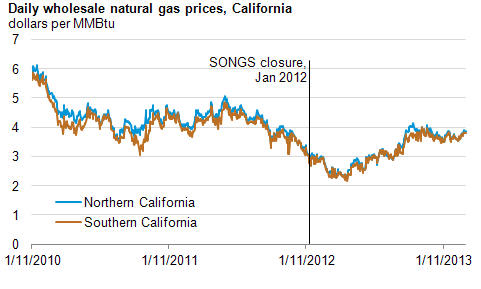
Note: Day-ahead, on-peak power prices from the California
Independent System Operator
for the SP-15 (Southern California) and NP-15
(Northern California) hubs.
Daily prices are averaged on a rolling 10-day period
to reduce apparent
volatility and make the persistent difference between the two
prices more visible.
The outages of both units at Southern California Edison's San Onofre Nuclear Generating Station (SONGS), starting in January 2012, have created a persistent spread in wholesale power prices between Northern and Southern California.
Historically, wholesale power prices for Northern and Southern California tracked closely with one another, indicating minimal market differences between the two areas. However, after the shutdown of SONGS in early 2012, the relatively inexpensive nuclear generation produced by SONGS had to be replaced with power from more expensive sources. Consequently, since April 2012 Southern California power prices have persistently exceeded Northern California prices, with the spread averaging $4.15/MWh, or 12% of the Northern California price.

Relative differences in natural gas prices do not seem to be driving the gap between Northern and Southern California power prices (see chart below). Although SoCal Citygate spot natural gas prices have increased slightly compared to the northern PG&E Citygate, this difference accounts for less than $1 per megawatthour of the average change in the wholesale power price in Southern California.
Thus, higher wholesale power prices in Southern California more likely are attributable to the need for more-expensive generation in that region to fill the shortage. To ensure electric reliability in the densely populated Los Angeles and San Diego regions, Southern California needs to use local generation sources and cannot solely rely on imported electricity to replace generation from SONGS. The major nearby alternative sources, however, are more expensive, and seem to be contributing to higher wholesale power prices.

Note: Daily spot wholesale natural gas prices for Pacific Gas
& Electric hub
(Northern California) and Southern California Edison Citygate
(Southern California).
In 2012, the continuing SONGS closure put pressure on the electric power grid operator, the California Independent System Operator (CAISO), to adjust both generation and transmission in order to meet summer demand for electricity, and in general, continues to change the generation profile in the area.
In a recent filing with the Federal Energy Regulatory Commission, CAISO requested changes to a transmission constraint rule in an attempt to resolve transmission congestion that is contributing to higher prices. The proposed change would reduce the price point at which CAISO relaxes a transmission operating limit and allows more electricity to flow.
Southern California Edison released an operational assessment on March 14 for restarting SONGS unit 2; the restart requires the approval of the Nuclear Regulatory Commission (NRC). The NRC is holding public meetings and conducting a technical evaluation of restarting this unit and has tentatively scheduled a decision for some time after May 2013. (DOE-EIA)
No comments:
Post a Comment